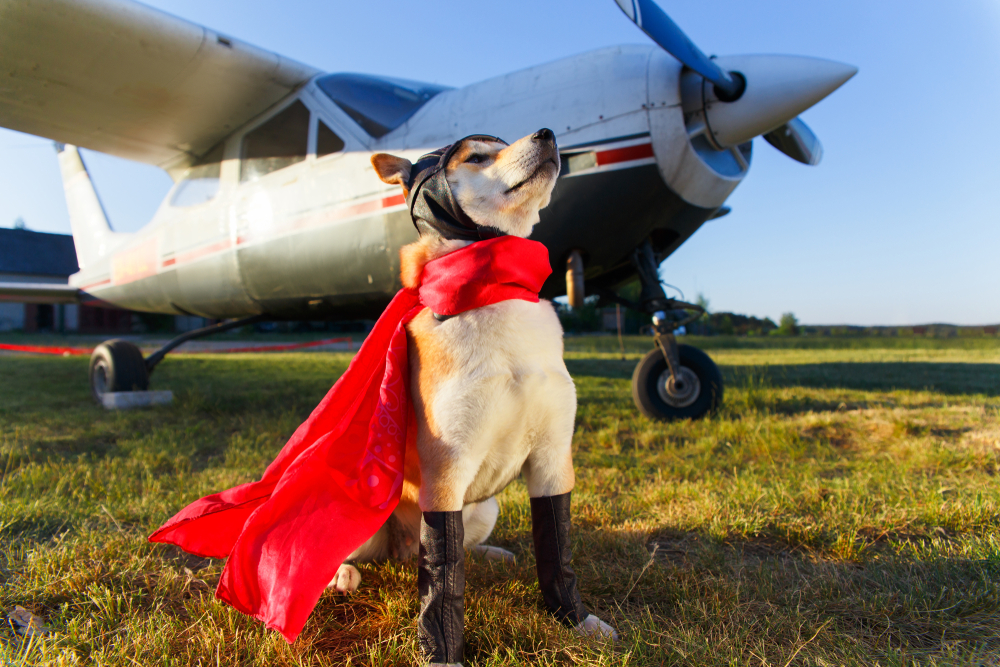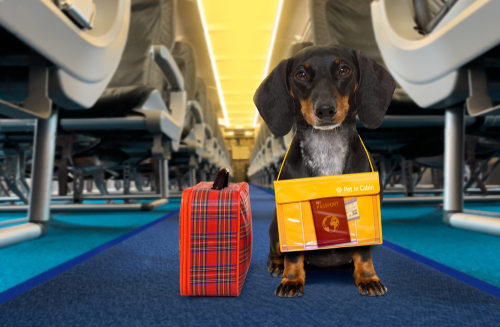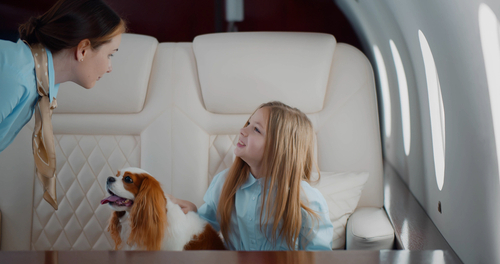In cases where pet sitters and doggy daycare won’t do—such as long-term trips or a relocation—you may have to fly your dog. Other times, you just can’t be separated from your best friend. The good news? Your little fluff ball will be so happy to be your new travel companion.
But how much does it cost to fly a dog?
The cost of flying a dog can run anywhere from $50 to $1,000 for a domestic flight and far more for an international flight.1 Now, before you ask how you’re supposed to plan for that kind of price disparity, take a deep breath and let us explain.
The cost varies depending on your specific pet, the destination, and the type of travel you’re planning. Read on to learn more about the costs and risks associated with flying your dog, as well as some tips for keeping your dog safe in the air.
Factors Influencing the Cost to Fly Your Dog
It’s impossible to pin down exactly how much it costs to fly your dog without having a lot of other information. The reality is that there are variables and factors which will influence the total price. Also note that, if you’re also traveling with cats, pricing may vary even more. To learn about flying with cats, visit our article explaining how to move cats across the country.
Regardless of whether or not you’re taking cats on your journey, it’s important to consider the below before flying with a dog:
Airline
Each airline has a different canine policy. For example, if you ask: how much does it cost for a dog to fly with Delta, you’ll likely receive an answer bespoke to the airline. Some airlines don’t allow pets over a certain weight or under a certain age to fly in the cabin, while others restrict the type of pets that can fly in cargo.
One ubiquitous factor across airlines is that it’s almost always costlier to fly your pet in cargo than to bring them in the cabin. However, it’s also riskier to do so.
Domestic vs. International Flight
You can usually expect to pay more to fly your dog internationally, especially if he or she must be situated in the cargo bay. You’ll also have to pay for vaccination records and any other paperwork required by a certain region.
Lastly, if you’re flying to a rabies-free country (New Zealand, Japan, and Australia, for instance), you might be required to source a third-party dog transportation service to bring your doggo into the country. This will contribute to a spike in the cost.
Distance
The distance you’re flying will also impact the cost of flying your dog. Longer flights or flights requiring a transfer will cost more than a shorter, direct flight.
Cabin vs. Cargo
Where your dog rides in the plane is one of the biggest differentiators in cost. If your dog can fly in the cabin with you, the price will be significantly lower than if they need to fly in checked baggage or manifest cargo. Typical price ranges for each of these are:2
- In-cabin – $50-$250 each way
- Checked baggage – $200-$400 each way
- Manifest cargo – $1000 and up each way
Ancillary Costs
There are other costs associated with flying your dog that you might not have considered. These include but are not limited to:
- The cost of the carrier
- Additional bag fees if your dog is riding in the cabin
- Veterinary costs for preflight requirements (examinations, vaccines, medications)
- Cargo crate, if needed
- Microchip in case your dog is lost
What are the Requirements for a Dog to Fly?
It’s important to note that each airline has different requirements and rules about flying with your pets. Furthermore, these can change at any time. Before making plans to fly with your dog, you’ll need to check with your specific airline and destination, if traveling internationally, about regulations related to flying your pet.3
In-Cabin
In the cabin is perhaps the safest way to fly with your dog because they are able to remain with you the entire time. However, there are quite a few restrictions:
- Weight – Most airlines restrict the weight of in-cabin pets to 20 pounds.
- Age – Pets typically need to be at least 8-12 weeks old to fly.
- Other – The carrier must be able to fit under the seat in front of you with your pet inside.
Checked Baggage
If your airline doesn’t allow in-cabin pets or your dog is too large, you may need to fly your dog in checked baggage. A few restrictions that might come into play include:
- Weight – Typical weight restrictions are between 20 and 75 pounds.
- Age – Dogs need to be 8-12 weeks old at a minimum.
- Other – Your dog will need a specific style of crate mandated by the airline. Your airline will also have requirements about water, food, and vaccinations.
Manifest Cargo
Manifest cargo is used to fly pets traveling alone or those that are too large to travel any other way.
- Weight – Typically pets over 75 pounds need to fly in manifest cargo.
- Age – The age range varies from airline to airline.
- Other – Some countries will only allow pets to enter if they are shipped via manifest cargo.
Is it Safe to Fly Your Dog?
There are always risks associated with travel. While the International Pet and Animal Transportation Association (IPATA) works to mitigate these risks, there are always factors you should take into consideration. Just like how you travel, the goal is to create the most comfortable and safe experience.
Risks of Flying Your Dog
When you ask: how much does it cost to fly your dog, you need to consider the financial cost and the potential impact on your dog’s health and well-being. Flying your dog does come with certain risks.4
- Stress – Dogs can easily become stressed in unusual situations. Stress can have long-term effects on pets, just as it can on humans. To mitigate the effects of stress after a long flight, consider learning how to massage a dog properly.
- Injury – Your dog can injure himself if he or she tries to escape their cage. Dogs can also scratch themselves or catch their collar on the wiring of their crate.
- Escape – The last thing any pet owner wants is a lost pet. If you don’t properly secure your dog’s crate they can escape in the airport or, worse, on the plane.
- Death – In rare cases, a dog can experience a fatal accident while on a plane.
How to Make Flying Safer for Your Dog
The good news is there are steps you can take to make flying safer for your dog. Some of the Humane Society’s top recommendations include:5
Choose Flights Carefully
Whenever possible, choose direct flights to avoid any issues with layovers or transfers. This will also help your dog disembark the plane faster when you land.
Be Wary of Weather
Some airlines restrict the months, temperatures, or flight locations in which dogs are allowed to fly as excess baggage. This is because the baggage area can experience extreme temperature shifts in hot and cold weather.
Know Your Breed’s Risks
Brachycephalic dogs, such as pugs, boxers, bulldogs, and others with flattened faces are prone to respiratory distress. The stress of flying can exacerbate breathing problems. Some of these breeds aren’t allowed on flights due to the excess risk. If your dog has any known health problems, you’ll want to consult your veterinarian before you fly.
The Right Carrier and Label
Airlines have specific requirements for carriers based on where your dog is situated in the plane. Make sure you check with the airline before you fly to ensure your carrier is acceptable. Your dog should be able to stand up and turn around in the carrier.
Additionally, the carrier should also have plenty of ventilation and a secure latch. 6You’ll need to label it clearly, following the airline’s specific guidelines.
Check Collars and Nails
Make sure your dog’s collar cannot get caught on the latch of their carrier to prevent choking. You should also trim their nails before the flight so they can’t injure themselves if they panic and try to escape.
Do Not Give Tranquilizers
Although it might be tempting to give your dog a tranquilizer to quell his or her nerves, you should only do so if recommended by your veterinarian. Instead, consider using canine CBD or their favorite toy for stress relief.
Carry a Photo
Should a mishap strike and the airline lose your dog (or if you lose them in the airport), you’ll want to have a picture to reference for identification. This will help the airport and airline staff create a frame of reference as they conduct their search.
Canna-Pet Can Help Your Flight Go Smoothly
At Canna-Pet, our number one concern is pet safety and comfort! We know flying with your dog can be a costly and stressful endeavor (for both parties). There are many risks involved and tons of factors to consider before making the decision to fly your little companion. Not only do you need the right crate but also the right treats and supplies your dog will require on the flight.
Here at Canna-Pet, we have CBD for dogs formulated to boost their vitality, well-being, and stress response. To complement their travel, our products can help induce relaxation, curb feelings of unease, and mitigate the discomfort of an unfamiliar environment.
No matter what method of transportation you choose, we hope your doggo has a safe, smooth, and comfortable trip.
Sources:
- Travel and Leisure. Here’s How Much it Really Costs to Travel with Your Dog. https://www.travelandleisure.com/trip-ideas/pet-friendly-travel/how-much-it-costs-to-travel-with-your-dog
- Pets2Fly. How Much Does it Cost to Fly a Dog? https://www.pets2fly.com/en/how-much-does-it-cost-to-fly-a-dog/
- American Kennel Club. Airline Pet Policies: A Guide to Dog Travel Requirements for Flying. https://www.akc.org/expert-advice/home-living/dog-pet-airline-travel-guidelines/
- Smithsonian Magazine. Is Taking Your Pet on an Airplane Worth the Risk? https://www.smithsonianmag.com/travel/is-taking-your-pet-on-an-airplane-worth-the-risk-6241533/
- Humane Society. Travel Safely with Your Pet by Car, Airplane, Ship, or Train. https://www.humanesociety.org/resources/travel-safely-your-pet-car-airplane-ship-or-train
- PetMD. What Type of Dog Carrier Do You Need? https://www.petmd.com/dog/pet-lover/what-type-dog-carrier-do-you-need






